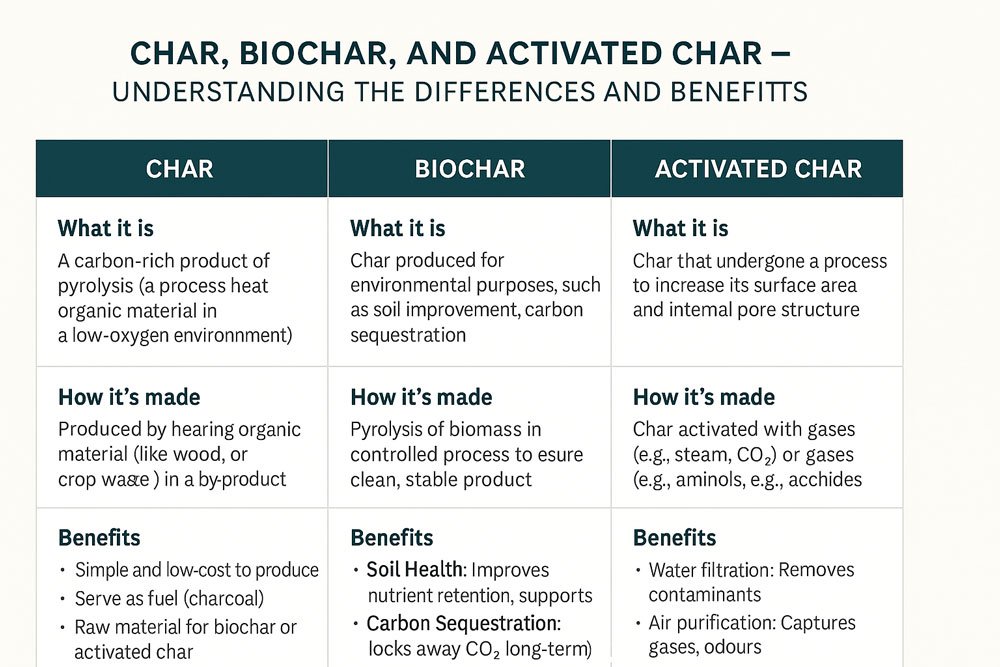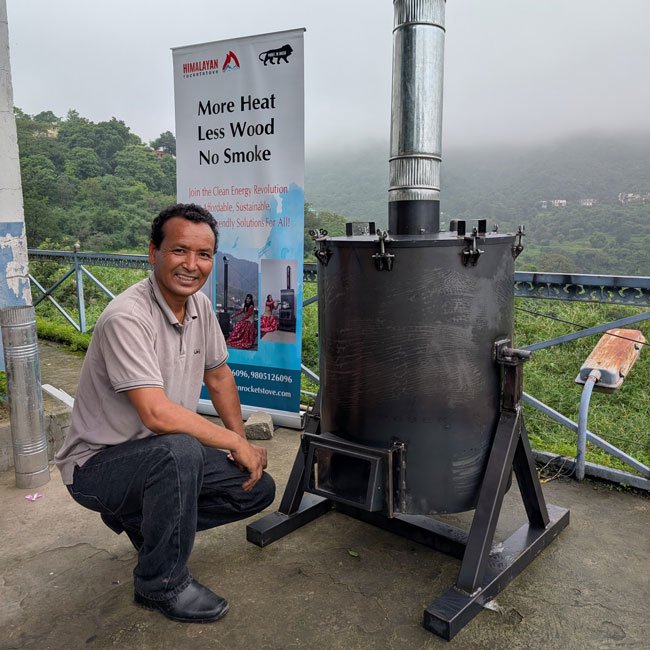At Himalayan Rocket Stove, we often talk about char, biochar, and activated char. These terms can be confusing—sometimes even used interchangeably—but each has distinct meanings, and in some cases, the same word can refer to two very different things depending on the context.
This guide unpacks what each term means, how these materials are made, and why they matter for health, environment, and climate.
⸻
1. Char – The Basic Building Block
What it is:
Char is the carbon-rich product created when organic material (wood, crop waste, nutshells, etc.) is heated in a low-oxygen environment—a process called pyrolysis. This drives off volatile compounds, leaving a porous structure made mostly of carbon.
How it’s made:
Char can be produced intentionally in a controlled burn (such as in our clean combustion stoves and BioBarrel systems), or as an accidental by-product of incomplete combustion (like leftover charcoal from a campfire).
Benefits:
• Simple and low-cost to produce
• Can be used as a fuel (charcoal)
• Serves as the raw material for more specialised forms such as biochar or activated char
⸻
2. Biochar – Carbon for Soil and Climate
What it is:
In its most widely accepted definition, biochar is char made for environmental purposes: to improve soils, lock away carbon, and sometimes to filter water or air. It’s valued for its stability, meaning it can keep carbon sequestered for hundreds to thousands of years.
How it’s made:
Biochar production follows the same basic process as char-making, but with a focus on clean, controlled burns and high-quality feedstocks to ensure the end product is non-toxic and rich in stable carbon.
Benefits:
• Soil Health: Retains water and nutrients, supports beneficial microbes
• Carbon Sequestration: Stores atmospheric CO₂ safely for centuries
• Waste Management: Turns agricultural residues into a valuable product
⸻
3. Activated Char – From Filtration to Purification
What it is:
Activated char (or activated carbon) is char that has undergone an extra process to dramatically increase its internal surface area and pore structure. This makes it incredibly effective at adsorbing contaminants and odours.
How it’s made:
Activation can be done through physical means (high-temperature steam or CO₂ exposure) or chemical means (using agents such as phosphoric acid or potassium hydroxide).
Benefits:
• Water Filtration: Removes chemicals, heavy metals, and odours
• Air Purification: Captures harmful gases and fine particles
• Medical Uses: Treats poisoning by absorbing toxins
⸻
Clarifying the Language: Two Words, Two Meanings
Both biochar and activated have different meanings depending on whether you’re in an environmental science, industrial, or agricultural context.
Biochar – Two Common Uses:
1. Scientific/Climate Definition: Stable, carbon-rich material intended for soil improvement, carbon storage, or filtration.
2. Agricultural/Permaculture Definition: Char that has been biologically activated or “charged” by combining with compost, manure, worm castings, or other biologically active material. This inoculates the char with microbes and nutrients, making it an ideal living fertiliser.
Activated – Physical vs. Biological:
1. Physically Activated Char: Processed to increase surface area for industrial, medical, or filtration applications.
2. Biologically Activated Char: Inoculated with beneficial microbes and nutrients to prepare it for soil use, turning it into a habitat for life.
Why this matters:
• Physically activated char for filtration isn’t automatically suitable for soil until it’s biologically inoculated.
• Biologically activated biochar for farming won’t necessarily have the high surface area needed for industrial filtration.
At HRS, our systems produce base char that can follow either path—into physical activation for purification uses, or into biological activation for regenerative agriculture.
⸻
The HRS Approach – Clean Heat Meets Clean Carbon
Our clean combustion technologies are designed to produce high-quality char as a by-product of heating. This means:
• Homes stay warm with less firewood and less smoke
• Indoor air pollution is reduced
• A valuable carbon product is created for soil, water, and air applications
⸻
Why It Matters
Char, biochar, and activated char represent one of the rare triple-wins in sustainability: they can improve human health, support ecosystems, and sequester carbon. By designing systems that make char instead of smoke, we’re not just reducing harm—we’re creating opportunities for regeneration.
⸻
If you’d like to learn more about our BioBarrel systems, stove technologies, or how to integrate biochar into your farm, garden, or project, contact us here.



Recent Comments